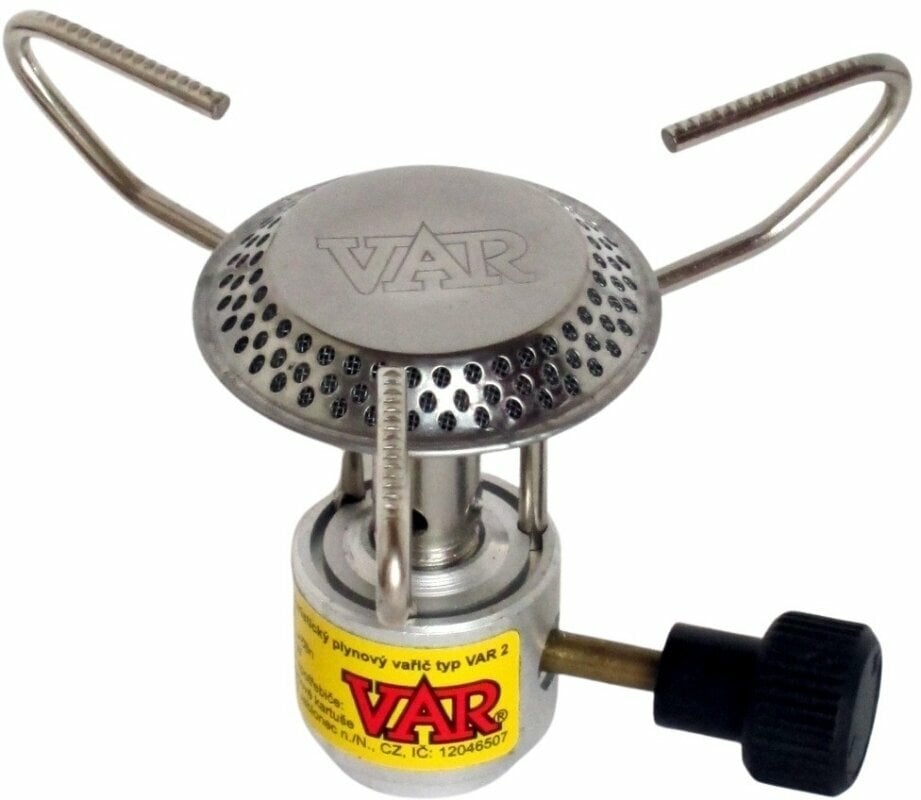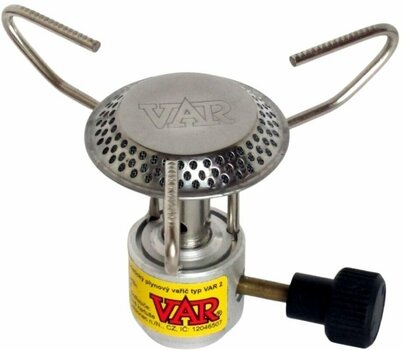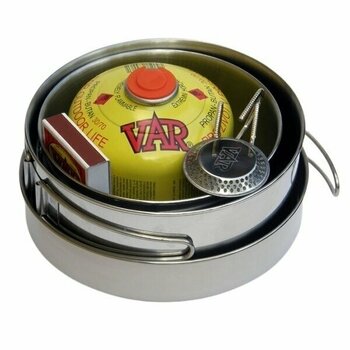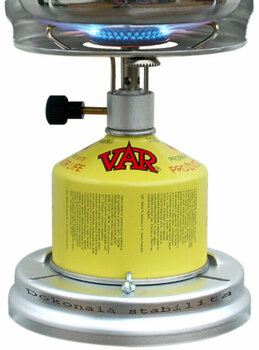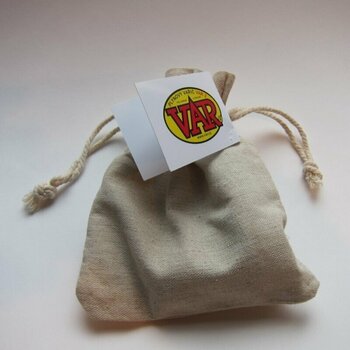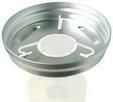The VAR 2 universal stove is suitable both for normal hiking and for mountain climbing of the highest level - the use of the leeward side is necessary. The stove provides surface heating of the container, so is therefore suitable for preparing food. When used with wind protection, it is more efficient in heating water compared to the previously produced VAR 1 stove.
- Hiking enthusiasts, mountaineers, performance athletes, water sports enthusiasts, and cyclists will appreciate the VAR 2 gas stove because of its minimal weight (110 g) and high performance in a compact size. Its simple operation, quick ignition, easy flame control, and low maintenance make the VAR 2 stove an excellent companion for your journeys.
- The VAR 2 stove becomes indispensable for popular road trips where each participant must take care of their own meals. It may be less suitable for traditional three-week camping in one location.
Performance
2800 W, a liter of water boils within five minutes
- The stove's operation is ensured by using propane-butane cartridges produced by various companies in a wide range of sizes, from 100 ml to 750 ml, allowing for a minimal equipment weight. To use Závetrie, you must use the VAR CGV 425 or Meva 230g and Meva 450g cartridges. The stove ensures a reliable seal when connected to VAR cartridges. If you decide to use cartridges from other brands, be sure to check for a perfect seal between the cartridge and the stove.
Gas consumption
- Gas consumption of the VAR 2 stove is dependent on the gas flow rate through the nozzle, which is the only constant variable. Therefore, determining gas consumption is relatively difficult. The variability of the nozzle flow rate depends on the gas pressure in the cartridge, which, in turn, depends on the gas temperature in the cartridge, influenced by the ambient temperature. For example, at an ambient temperature and gas temperature of 14°C, in a 30:70 P-B gas cartridge, the pressure is 210 kPa, and with the valve fully open, the gas consumption is 150 g/hour. A VAR CGV 220 cartridge with 220 g of gas should last for about 1.46 hours at full power - 220/150 = 1.46. This is theoretical because rapid gas consumption cools the cartridge, reducing gas consumption and the stove's performance. In practice, the cartridge lasts for about two hours. All gas consumption data is either highly technical and not practical or vague and misleading for practical information.
Practical experience is the only reliable guide
- It is proven that with consistent use of wind protection, heating the required amount of water, and cooking foods that don't require long boiling times, such as potatoes or rice, a single 220 g cartridge can last comfortably for a week for two people.
- It's advantageous to have two cartridges and, first, confirm this claim, so you don't stress, and you shouldn't economize unnecessarily at the expense of drinking enough water. The second full or nearly full cartridge will be ready for another action for up to a year without losing its contents.
- Note: The VAR CGV 425 cartridge behaves similarly to the VAR CGV 220, but due to its larger vapor capacity, it has slightly higher performance.
Product instructions:
Important
- Before connecting the stove to a gas cartridge, thoroughly familiarize yourself with this user manual. Regularly refer to the instructions and be cautious. For this reason, keep the manual carefully for future use; it also serves as your warranty.
- Please be aware that you have chosen to work with a heat-producing appliance, and all devices that utilize any form of energy can be very dangerous if operated incorrectly.
Caution:
- The operation of this appliance consumes air (oxygen) and produces carbon monoxide. Do not ignite or use this appliance in poorly ventilated areas, indoors, in tents, or in a vehicle. Using a stove to heat a closed space is life-threatening due to the inconspicuous carbon monoxide poisoning!
- The stove may only be operated by an adult according to this manual; do not entrust the operation to children or individuals with mental or physical disabilities. When in operation, the stove must be placed in a stable position and kept under constant supervision.
- The universal stove VAR 2 is suitable for both regular hiking and high-level mountaineering expeditions, where wind protection is required. VAR 2 is appreciated by enthusiasts of mountain, performance, water, and cycling tourism because it has minimal weight and high performance with negligible dimensions. In conventional camping at a fixed location, it is possible to cook using a two-kilogram Meva gas cylinder with an adapter.
To operate the stove safely, it is MANDATORY to STRICTLY follow the following instructions:
Connecting the stove to the cartridge
- This stove is designed to operate with VAR CGV 220 and VAR CGV 425 cartridges, or Meva 230 g and Meva 450 g cartridges containing a liquid propane-butane gas mixture under constant pressure in a 30:70 PB ratio.
- However, if you decide to use a cartridge from a different brand, the manufacturer cannot guarantee the airtightness of the stove-cartridge system. In this emergency case, make sure to carefully check the sealing of the cartridge-stove system, as described in section 1.6.
- The cartridge must be manufactured according to EN 417 standards and equipped with a self-sealing valve with a 7/16'' threaded connection. The use of other cartridges, especially of questionable origin, can be dangerous.
- Before connecting the stove to the cartridge, ensure that the sealing ''O'' ring is in perfect condition. If this component shows signs of wear, replace it. The dimensions are 12x8, and it can be purchased where the stove was bought. To remove the worn sealing, use the sharp end of a thicker needle, and to install a new sealing, use the blunt end of a needle.
- Check if the control valve of the stove is completely closed in the direction of the ''-'' sign on the control knob.
- Connecting the cartridge to the stove is only possible in an outdoor environment, away from people and any sources of ignition, such as open flames, electrical discharge, and so on.
- After connecting the stove to the cartridge, use a soapy solution to check for perfect sealing of this system. In case of an emergency, use your sense of smell and hearing, but never an open flame. Perform these actions exclusively in an outdoor environment.
- If the system shows signs of leakage after assembly, immediately move to an open space where there is no proximity to an open flame or danger of electrical discharge, and disconnect the system quickly. Send the stove and the cartridge to the manufacturer without delay.
- Note: Soapy solution can foam spontaneously, creating an impression of leakage. A reliable test involves dismantling the burner and stove connected to the cartridge, and submerging them in a container of water. If no bubbles appear, everything is fine. Then, thoroughly dry everything, preferably with a hair dryer.
- All the instructions mentioned apply to replacing an empty cartridge with a full one.
- Note: To make the odorless propane-butane gas leak perceptible, an odorant with a strong smell is added to it. Unfortunately, this odor can stick to the cartridge and stove for a while after the stove is disconnected from the cartridge. A slight smell does not necessarily indicate a leaking cartridge.
- The stove and the cartridge are equipped with a right-hand thread for their connection. When attaching the stove to the cartridge, proceed with care to avoid cross-threading (i.e., ''screwing through the thread''), as this can lead to the stove being damaged due to improper operation. During the initial tightening of the stove onto the cartridge, you may encounter slightly increased resistance. This increased resistance is not a cause for concern regarding the stove's damage. The thread is made with high precision, and the initial tightening calibrates it. Subsequent attachment should be much easier. To prevent thread jamming during the initial attachment, lightly coat it with Vaseline, and do not remove it!
- When screwing the stove onto the cartridge, a slight hissing sound may be heard as the gas valve in the cartridge is opened by the puncturing pin. Further rotation will seat the sealing on the cartridge and ensure the sealing of the cartridge-stove system. Additional forceful, unnecessary tightening will quickly wear out the sealing or damage the stove's thread! By following these instructions, the longest possible stove life is guaranteed, and according to the given principles, the possibility of connecting the stove to a cartridge 1000 times is practically unused. Occasional light application of Vaseline to the stove's thread also significantly extends its lifespan.
Ignition and Operation
- The cartridge stove is secured in a vertical position. The container supports are spread out and secured in the active position. Gently turn the control wheel to the left in the direction of the ''+'' sign on the control wheel, and ignite the flame. It is not advisable to fully open the regulator when lighting the flame. If the cartridge has been in the cold and at rest for a while, it should be thoroughly shaken before use, otherwise, the flame may flicker for about one minute after the stove is ignited. If you place a cooking pot on the stove just before lighting the flame, this phenomenon is almost eliminated. It's a bit inconvenient, but it's best to momentarily block one of the four primary air inlet holes with a finger.
- When using a completely new cartridge that has been exposed to heat for a long time, a large yellowish flame may erupt after the stove is lit. Immediately close the regulator valve to a minimum until the flame calms down. This phenomenon will certainly occur if the stove with the cartridge is tilted strongly.
- During operation, prevent the boiling of liquid from the cooking pot; otherwise, it may damage or completely destroy it, typically including the stove. Keep an eye on the stove at all times during operation. Maintain a safe distance from flammable substances during operation - at least 0.5 meters. Do not place flammable materials directly on the stove. If you have doubts about the correct functioning of the product, do not hesitate to contact the manufacturer.
End of Operation
- To end the operation, turn the control wheel to the right in the direction of the ''-'' sign until the flame goes out. Then, it is possible to detach the stove from the cartridge by unscrewing it. This operation must be performed only after the stove has completely cooled down. Never remove the stove from the cartridge during operation!! After removing the stove from the cartridge, lift the container supports out of the retention groove and fold them toward the control wheel. After finishing the operation, always detach the stove from the cartridge to prevent the cartridge from emptying due to a slight leak. This could be caused by dirt that gets between the stove and the cartridge, so be sure to keep this area clean.
Emergency Warning
- In case of a flame spillover beyond the active part of the stove, immediately close the control valve and gently tighten the stoveto the gas canister. If the flame continues to appear, extinguish it with a stream of water, which you typically have ready for heating. If you cannot extinguish the flame, discard or kick away the stove along with the gas cartridge to a safe place. Ensure that nobody approaches the stove within a distance of less than 20 meters until the gas has burned out. Subsequently, send the stove back to the manufacturer without delay.
Important Notices
- It is not permissible to use two or more stoves next to each other to heat a single container. The stove must not be used for purposes other than heating food and beverages in a container. The active components of the stove, such as the stove itself, container supports, or wind guards, will be hot during operation and for approximately 10 minutes afterward, so avoid touching them during this time. Never use a stove that shows signs of damage or has defective or worn seals. Handle the stove with care and protect it from falling to the ground. Do not make any modifications to the stove.
Dismantling, Cleaning, and Assembling a Camping Stove
- A camping stove consists of two main parts: the valve body and the stove, which are connected to each other through threads and sealed with an ''O'' ring. It is necessary to disassemble these parts to clean the nozzle properly. Even a slight blockage can significantly reduce the stove's performance.
- Do not use needles or pins for cleaning because they can damage the nozzle and lead to the breaking of the needle tip inside the nozzle, which can ruin the stove. To clear any blockages, you can often create suction with your mouth. After cleaning the nozzle, make sure to tighten the stove with the appropriate force to ensure a seal between the stove and the valve.
- A nozzle cleaner can be created by cutting threads from sewing needles (available in haberdashery stores) or using the thinnest guitar string.
Storage and Transport of the Camping Stove
- Always store the camping stove in a dry, non-aggressive environment.
- When carrying it in a backpack, the stove is best protected in the provided case and inside a cooking pot.
- Always transport the stove separately from the gas cartridge.
Cartridge
- The cartridge contains liquefied, highly flammable propane-butane gas at a constant pressure. Protect the cartridge from excessive heat (above 50°C) and exposure to direct sunlight. After use, do not forcibly open the cartridge or throw it into a fire. Do not spray the gas towards an open flame or hot surfaces. After using the stove, unscrew it from the container. The cartridges are intended for single-use only and should not be refilled. Dispose of them in designated waste containers provided by your municipality or directly at a recycling center after ensuring they are completely empty. Follow the instructions on the cartridge label.
Technical data and disposal:
- Brings 1 liter of water to a boil in 4.5 minutes. Fuel: Propane-butane up to 0.8 MPa. Nozzle diameter: 0.30 mm. Weight: 110 grams. Dimensions when folded: 90×80 mm. Maximum permissible load on the stove, including its contents: 2 kg with a maximum container diameter of 200 mm. After the stove reaches the end of its life, dispose of it at a recycling center, including the packaging.
Gas Consumption and Stove Power
- The maximum power of the stove with the valve fully open depends on the gas pressure in the cartridge, which, in turn, is influenced by the temperature of the cartridge. The warmer the cartridge, the higher the gas pressure inside.
- At temperatures well below the freezing point, the liquid gas ceases to evaporate, and the stove cannot operate. This is not a stove malfunction.
- At a gas consumption rate of 110 g/hour, the stove has a power output of 1400 W. At a gas consumption rate of 220 g/hour, the stove has a power output of 2800 W.
 Instrumentos musicais
Instrumentos musicais

 Desportos aquáticos
Desportos aquáticos


 Desporto
Desporto


 pt
pt





